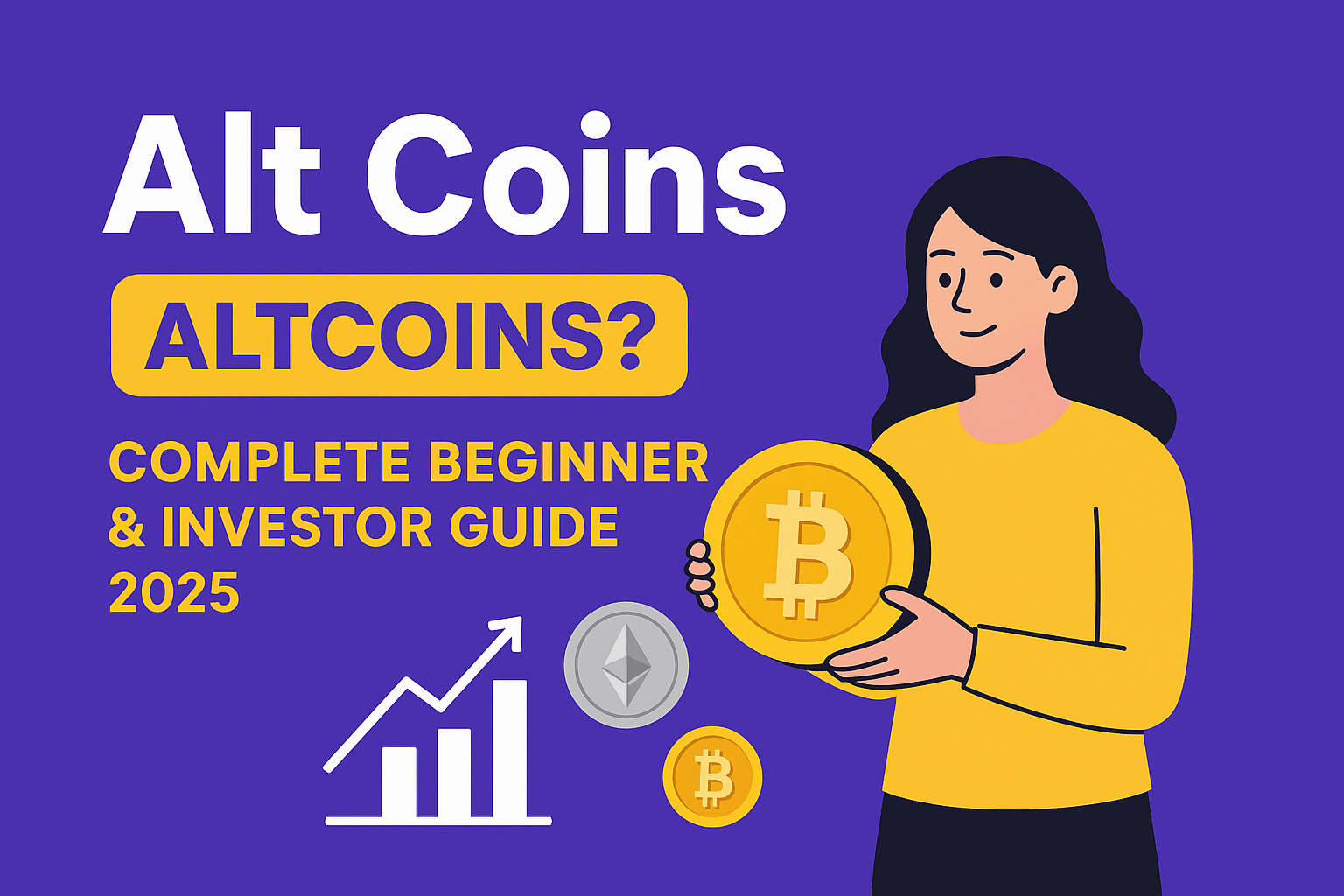Welcome! In this guide, you’ll learn everything about alt coins. A thriving part of the crypto world. You will understand what is alt coins.
How they differ from Bitcoin, their technology, types, benefits, and risks. How to invest safely. Let’s dive into this exciting journey. It’s full of clear examples, useful tables, and easy to follow explanations.
What Are Alt Coins and How Are They Different From Bitcoin?
Alt coins are any cryptocurrency other than Bitcoin. They are digital money but often come with extra features. For example Ethereum lets you build apps on its blockchain. Bitcoin’s main use is as a store of value. Alt coins may excel in speed, smart contracts or privacy.
When you compare alt coins to Bitcoin you notice the differences. Bitcoin has a fixed supply and simple design. Many alt coins like stablecoins or utility tokens serve specific markets. Alt coins can react faster to change but often come with more risk.
History and Evolution of Alt Coins in the Crypto Market
The story of alt coins began soon after Bitcoin launched in 2009. In 2011, Litecoin appeared as one of the first alt coins. It aimed to process transactions faster. Soon after, Namecoin and Ripple arrived, each offering new features.
Over the next decade, thousands of alt coins surfaced. Some addressed privacy, others created tokens for smart applications. Investors in the USA and worldwide welcomed these innovations, driving a market full of variety and competition.
How Do Alt Coins Work? Understanding Their Technology
Every alt coin runs on a blockchain or similar distributed ledger. A blockchain stores data in linked blocks so no one can alter the records easily. Many alt coins use consensus methods. Like proof-of-stake or proof-of-work to validate transactions.
For instance Ethereum uses proof of stake to secure its network. Some alt coins like Cardano or Polkadot add layered architecture and specialized chains. The technology behind alt coins not only handles money but also supports apps, voting, and smart contracts.
Types of Alt Coins You Should Know About
There are many alt coins, each for different purposes. Stablecoins like USDC and USDT are tied to the US dollar to reduce volatility. Utility tokens like BNB or ETH give access to platform services. Security tokens promise dividends or ownership like stocks.
Meme coins like DOGE and SHIB got famous through community hype. Privacy coins like Monero and Zcash are for untraceable transactions. Each one has its own features and serves different investor needs.
Benefits of Investing in Alt Coins
Alt coins offer potential for higher growth. Some projects gain quick adoption and exponential returns. You also get portfolio diversification by adding alt coins. That doesn’t move exactly like Bitcoin.
Furthermore, alt coins often pioneer innovations in DeFi, NFTs and Web3. These ecosystems expand investment opportunities. For US investors exposure to alt coins means tapping into a broader crypto ecosystem.
Risks and Challenges of Alt Coin Investment
Alt coins bring higher volatility than Bitcoin. Prices can swing wildly in hours. Some projects turn out to be scams, such as rug pulls or fake teams.
Regulatory risk looms, especially in the USA. Authorities may ban tokens or impose stiff rules. You must also be wary of low liquidity coins where it’s hard to sell quickly in emergencies.
Best Alt Coins to Watch in 2025
Looking ahead to 2025, several alt coins stand out. Ethereum continues strong, powering many blockchain apps. New players like Polkadot, Solana, and Cardano grow fast in DeFi and smart contracts. Emerging AI‑integrated coins show promise too.
| Alt Coin | Market Cap | Use Case |
| Ethereum | High (top 2) | Smart contracts & dApps |
| Solana | Mid‑high | Fast DeFi & NFTs |
| Polkadot | Mid | Interoperability across chains |
| Cardano | Mid | Research‑driven smart contracts |
How to Choose the Right Alt Coins for Investment?
Select alt coins by checking fundamentals. Investigate the project team, roadmap, and past partnerships. Study trading volume and market cap to assess stability.
Also explore project utility. Does the alt coin solve a real problem? For instance, tokens that power finance apps or gaming platforms may hold long‑term value in the US market.
Where and How to Buy Alt Coins Safely?
In the USA you can trade on these trusted exchanges such as Coinbase, Kraken, or Binance.US. They support many popular altcoins and follow regulations for safety. Once you buy move your coins to a secure wallet.
Hardware wallets like Ledger or Trezor are great. Avoid scams by not using unknown ICOs and copy links instead of clicking random ads.
Future of Alt Coins – Are They Worth It?
Alt coins could reshape finance through decentralized platforms and tokenized assets. When more people adopt DeFi and Web3, alt coins may grow further in value.
Meanwhile US regulation will shape their future. If laws stay balanced and supportive, alt coins benefit. If rules tighten too much, projects may struggle or move offshore.
FAQs About Alt Coins
What is the safest alt coin to invest in?
Many consider Ethereum or well‑established tokens in utility categories as safer.
Can alt coins replace Bitcoin?
Some hope so, but Bitcoin remains the pioneer.
Are alt coins legal in the USA?
Most yes, but some tokens may face scrutiny from regulators.
How do I know which alt coin will rise?
Look at a project’s roadmap, community strength, partnerships, and real use cases.

